It’s been almost three weeks since we brought our young turkeys to live here. Just in that short time, we’ve seen some significant growth in these birds.
On arrival, the turkeys spent the first week in the brooder. They probably didn’t need to at five weeks, as they were already acclimated to outdoors. However, they were a little older than we anticipated, and we needed a few extra days to finish building the turkey pen.
The pen is just shy of 200 square feet, which is quite sizable for four birds. Eventually we will pasture these birds, during the day, and the pen will be primarily for security from predators at night.
In the interest of reusing materials, rather than building the pen from scratch, we modified the previous owner’s fenced-in flower garden area to accommodate the turkeys. The structure itself was still sturdy. Old buried irrigation pipes were removed, miles of split old soaker hoses, and rusted metal staples, along with a lot of buried poultry wire, no doubt to keep the gophers at bay, that had since rusted and disintegrated. We installed a wire roof, and a solid section of roofing over the roosts to help provide shade, and give the birds protection from our persistently unpredictable rainy weather. If we make turkeys a permanent feature on the farm, we’ll no doubt construct something more aesthetically pleasing in the near future, but for now, this pen is working out well.
With that done, the turkeys were turned out in the pen, and very happy to be outside full-time. The following is a short video we took as the turkeys explored their new home for the first time.
It became clear once the turkeys were out in the pen though, that they seemed to be imprinted…not on humans…but on chickens! They apparently were raised near lots of chickens as babies, and it shows!
When it gets hot outside (and it’s been marvelously warm this week) our chickens run for the cool shady sandpit underneath the coop. From the outside of the coop, this area is covered, only open on the side facing the run, so when the chicks are relishing the cool shade under the coop…guess what? The turkeys can’t see them…and the turkeys don’t like that. Really…hear it for yourself!
I never knew four young poults could make such a racket! If I bribe our young chickens out from under the coop, with some tasty greens, the second one pops its head out…the turkeys go quiet again. It’s a bit like having a remote control, and the most bizarre thing we’ve seen in a while. Good thing we have chickens, or our turkeys might never be quiet!
We have noticed a problem with one of our Royal Palm/Bourbon Red poults over the past few weeks. We had noticed something odd with this turkey shortly after we brought it home, and it began to manifest itself more severely once out in the pen, especially at dusk. This bird tends to circle a lot, always spinning in the same direction.
Once out in the pen, we had a couple of encounters where we clearly startled this turkey, and we realized this bird might have limited or absent vision on one side. Further examination showed that this turkey appears to be completely blind in one eye, but is sighted in the other. This could be congenital, or possibly secondary to an early trauma, we’ll likely never know, but otherwise this turkey seems completely normal…well, normal for a turkey.
The first few evenings the turkeys were out in the pen, the birds were trained to use the roost, which we set at 30 inches in height. Once the sun was completely set, we’d enter the pen, and usually find the brood in a pile on the pen floor. One by one, they were carefully placed on the roost, where they seemed only too happy to settle in for the night. All except one that is. After falling off the roost, repeatedly, we elected to simply leave our half-blind turkey to figure out its own favorite place to sleep at night. Clearly this bird prefers to sleep on the floor near his pen-mates, though thankfully, not right underneath them.
Due to this visual impairment, we need to be more aware when approaching the flock of making our presence known. On at least one occasion, we startled this bird so badly that in a mad panic, it flew directly into the pen fencing, and fell to the ground, landing on his back, almost stunned. Overall though, it seems to manage very well, especially during daylight. Turkeys don’t see well at night as it is, but with one bad eye, the world becomes a very confusing and disorienting place for this bird.
Our only concern is that this turkey will be more prone to accidentally injuring itself, and will be more at risk with the predators that wander through the farm. It clearly can’t judge distances well when attempting to fly across the pen, or toward the roost, and is prone to falling from perches, but we’ll watch this one closely for now.
In our next turkey-centric Fowl Friday post, we’ll discuss some of the more unique anatomic terminology that applies to turkeys, once some of their more turkey-like features develop further, and should have a better idea as to our ratio of males (Jakes) to females (Jennys) at that time.
In the meantime, we leave you with a little “turkey salad”. We’re revamping our lettuce beds with new transplants today, so the turkeys had an extra lunch-time treat. Apparently they really enjoy organic oakleaf lettuce!


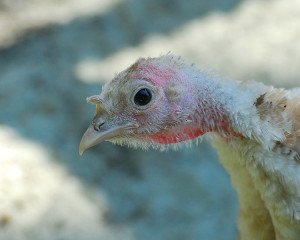
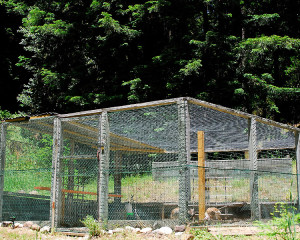
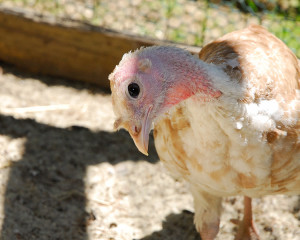
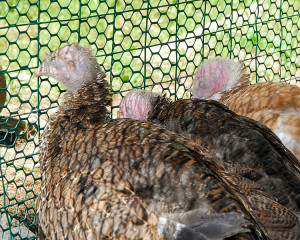
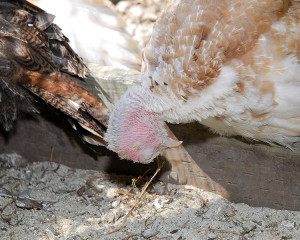
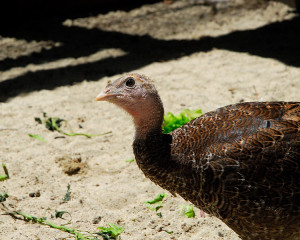







Love that turkey salad! And they DO make quite the racket, don’t they?
.-= villager´s last blog ..Happy Birthday =-.
How exciting! I guess I missed the post about you getting them. Any fowl that finds it’s home with you is a lucky one. I hope your little blind turkey lives a long and happy life there.
.-= Catherine´s last blog ..Lot’s of new blooms for Fertilizer Friday. =-.
LOL, this was so fun and it made me laugh, thanks and gonzo with the lettuce already! Hmm, I am curious if the half-blind juvie get picked on by the others?
We have that concern too. That turkey is often separated from the others. I think they can tell something is not quite right with this one. We’ll just have to keep an eye on them for now.
I wonder why they call them Jennys and Jakes? They sound like hours of amusement.
.-= Deborah at Kilbourne Grove´s last blog ..Tomato Towers =-.
That’s amazing how they have imprinted on the chickens! Your turkeys, and especially the half-blind one, are fortunate to have such a good home!
.-= debsgarden´s last blog ..A Gardenia For Me =-.
Hilarious! They sure are keeping y’all busy (and me entertained with all these adorable videos!)
.-= Christine´s last blog ..Field Trip: The Fragrant Path of the Diablo Foothills =-.
OMG, these guys are just so cute and full of personality! I really like the idea of the repurposed garden area for the pen. A great use of existing materials and a simple but really effective structure for keeping these young’uns housed.
.-= Camissonia´s last blog ..The Douglas Iris finally blooms and a mountain meadow planter =-.
What fun. You get to enjoy them twice , first as pets and later as dinner!
.-= melanie´s last blog ..Germinating Seeds Outside =-.
How cute! Turkeys eating lettuce sure are funny. It looks like the light colored turkey on the left is getting less lettuce than the other ones, is this the one with the eye damage?
.-= Angela´s last blog ..Garden Residents: California Quail =-.
Yep, that’s the one, on the left for the majority of the video. Overall that turkey seems to do fine though.
Awwww, those are so cute! Love seeing their progress, and the videos are so fun.
.-= Floridagirl´s last blog ..The Summer Tulip =-.
Clare, I LUV your videos! the second (and third) is hilarious. Don’t you just love to watch their behavior (rhetorical)? I can sit all day (but don’t) and watch the various birds and their mannerisms… a wonderful experience they provide.
PS: there is promise of a sunny day, but so far overcast; many of my bush bean seedlings that were about to emerge have rotted; oh well, do it again. 😉 Have a great weekend.
.-= Diana´s last blog ..The Rains Keep Coming =-.
Turkeys are big business here in NC. So there are LOTS of turkey farms, many many enclosures….Chuck always call them turkey concentration camps lol.
.-= Kyna´s last blog ..Birthday Trip Pt 1~University of Virginia =-.
My kids had so much fun watching your turkey movie. They are definitely fun to watch. How interesting that they sometimes sleep with their heads upside down. My daughter mentioned that our dogs do that too.
PS. Thank you very much for your kind comments.
‘Normal for a turkey’ I love that 😀 Do you think there is a chance that the one with the visual problems might learn to compensate over time?
We’re hoping so. Animals can be remarkably adaptable. I had a friend in England whose old terrier was blind AND deaf. Always knew when she came home though. She figured the dog could sense the car’s vibration in the driveway. Dog did great, just so long as you didn’t move furniture around the house. This turkey at least is sighted in one eye. Yesterday it did try to jump up on a block we put in the pen to help it get to the roost, which was progress. Jumping off it though was…well…less than graceful. Maybe with practice though, it will be interesting to see if acclimates to the pen, and gets used to where things are over time. I’d just be a little more careful with this bird loose in the garden.
I just love the chicken and turkey utubes. I am raising birds vicariously through you. I love em!
Love the turkeys! I look forward to watching them grow and finding out the sexes. Do you plan on processing them yourselves?
Yes, unless an alternative presents itself, we do expect that we’ll have to do the processing ourselves. All part of the experience of raising one’s own food 😛
They sure make some noise Clare and they are such funny characters. I know so little about turkey’s its great to learning all about them.
I’m watching your turkey videos while listening to my hens cackle. Pretty funny juxtaposition. I admire your courage in planning to process your turkeys yourself. I don’t think I could face the guts and smell of wet feathers.
Clare,
I absolutely love your videos! If someone told me years ago I would be sitting at my computer, while it is pouring rain watching a video of young turkeys eating hand held salad greens to some fabulous jazzy music I would have laughed. Your posts are so entertaining and educational! I hope the little fellow with the blind eye will fare OK outdoors with your roaming predators. Hopefully the others will alert him. What voices they have… they were calling out for someone they had lost! ;>)